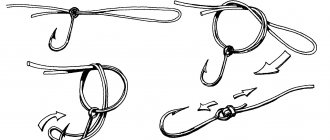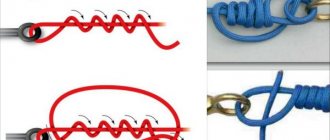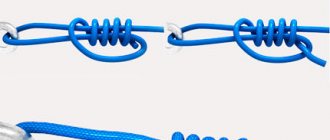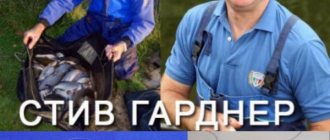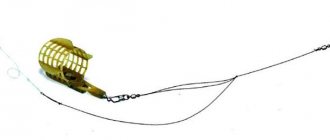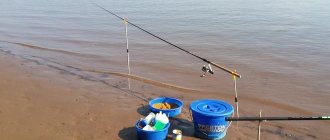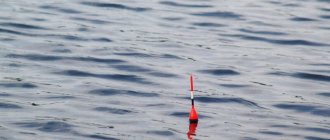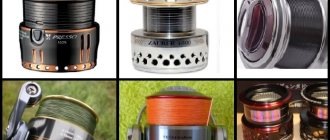When fishing with heavy gear, it often happens that the line breaks when casting. This happens due to the fact that when swinging the fishing rod and sending the equipment to the right place, increased loads are placed on it.
If the fishing line was previously damaged by stones or shells located at the bottom, then after a while a break is inevitable. When casting, the tackle constantly flies off at the most unexpected moment, and then it needs to be tied again. To prevent this, a shock leader is used in feeder and carp fishing.
What is a shock leader and why is it needed in fishing?
A shock leader is a piece of fishing line long (usually from 2-3 to 6-12 meters), tied to the main fishing line. Next, a weight, a feeder spring, a nozzle and other elements of the tackle are attached. When using a shock leader, it is he who is responsible for the operation of the fishing line when the rod swings during the casting process.
If, for example, the breaking force of the main line is 4 kg, and the permissible load that falls on the shock leader is 12 kg, then you can already use heavy loads or springs. Moreover, a fairly thin main line will allow for long casts without creating much resistance to the underwater current.
The classic shock leader for carp fishing is available in 2 lengths of the fishing rod used. When fishing at short distances, this size can be made smaller to increase the sensitivity of the rig.
The shock leader is used not only for carp fishing, but also for spinning. The heavier the tackle, the more appropriate its use. It is especially relevant in carp fishing. It fits only for one fishing trip; for the next one you need to install a new one.
Shock leader length
The length of the shock leader on the feeder is approximately two rods - so that when casting, the impact occurs only on this section of the equipment. Usually the shock is tied to the coil at home, since the knot must be made carefully so that the connection point is neat and small in size for normal passage through the feeder rings. Calculating the required length is simple - multiply the distance from the coil to the tip of the quiver tip by two. The correct position when casting - the shock occupies the overhang of the equipment, the distance to the reel and 5 turns on the spool.
Advantages and disadvantages of the solution
The main advantage of a shock leader for a feeder is that it allows you to avoid shooting off the feeder with bait during casting. This is especially true when fishing at a very long distance of 90-120 meters.
It also prevents the line from breaking when fishing on extreme bottoms. Since the shock leader is larger in diameter, unlike the main fishing line, it is more difficult to rub it against stones.
These are the main, but not the only advantages and situations for which a shock leader is needed:
- The shock leader, made of thick monofilament fishing line, will protect your finger from cuts when casting heavy loads over long distances. But just for this reason there is no need to use a leader; it is enough to buy a fingertip for this.
- Helps when fishing for trophy specimens in the last meters near the shore , often this is where the carp makes the last strong push to leave.
- If the leader is made of monofilament, then when fishing, due to its elasticity, the latter plays the role of a shock absorber . This, of course, is not the same as tying a feeder elastic band, but in some cases this also helps with fishing. You also need to take into account that for this the leader is knitted at least 15 meters. And in this case, the other side of the coin arises: the longer this thick segment, the more the sensitivity of the equipment decreases.
The disadvantages include:
- Aquatic vegetation often clings to the knot at the connection site , which then clogs the rod's guides.
- The knot when connecting the fishing line and the leader sometimes does not pass well through the guides of the rod , so the casting distance deteriorates and over time simply spoils the guides.
- Windage increases in windy conditions . In this case, it is necessary to clarify that the further the distance to the bait spot, the lower the overall windage of the equipment due to the presence of a thin main line.
- The shock of the monofilament leader worsens the sensitivity of the tackle , so you may miss a carp bite.
Why do you need a shock leader in the feeder?
A shock section in a feeder is needed when fishing occurs over long distances with heavy feeders in the current. To ensure that the feeder equipment flies out well when casting, a thin braided cord is used. In addition, thin braid is less likely to inflate with an arc under the influence of the current. The shock leader in bream fishing on large rivers is a mandatory part of the feeder equipment. Usually, on heavy river feeders, thin braiding is used, 0.1-0.14 mm in diameter, and it is expensive and of high quality. When casting forcefully, such a thin web can easily come off under the influence of a heavy feeder.
You need to work carefully with a thin and good main cord on the feeder, protecting it from unnecessary loads and damage - then this section will last a long time. In addition to safety when casting, the shock takes on the impact of stones and shells on the edges. In the event of damage, there is no need to cut off a piece of the expensive main braid - we simply replace this fuse completely.
Another plus is that the rigs are knitted directly on this piece. This component of the equipment needs to be changed after difficult fishing. This reduces the consumption of the main cord - it is not involved in knitting installations. During power casts, you can damage your finger, which presses the thin braid to the rod. The diameter of the leader is larger - the likelihood of a cut is less.
Should I buy it or knit it myself?
As a rule, fishermen prefer purchased leaders; they are easy to tie to a fishing line. The main advantage is low cost. Moreover, purchased shock leaders do an excellent job with their main task and are enough for amateur fishing.
However, there is another option - buy a shock leader for carp fishing. Its advantage is that it copes with increased loads much better and is much stronger. But this leader is quite expensive - the cost of branded products starts from $5 per piece.
You can also buy a cone shock leader. This is a piece of fishing line where one end is thicker than the other in diameter.
What braided cord should I use for my shock leader?
Since the shock leader is a kind of consumable, there is no point in buying expensive braided cords for this purpose, like Daiwa Tournament.
Feeder Concept Powersink
In fact, why not? A very good braided cord, characterized by a dense weave, and therefore does not become shaggy when running through the guide rings. The design is four-core, the cord is treated with a special impregnation that protects against ultraviolet radiation and increases slipperiness (in the context of manufacturing a shock leader, this advantage can hardly be called significant).
For our purposes, a braided cord with diameters of 0.153 and 0.172 millimeters is best suited. The price tag for this model varies at around 16 US dollars for a 150-meter marking.
Fishmaster W Higher strength PE
The PE cord that I am currently using. It has an excellent price-quality ratio, has high strength and resistance to mechanical stress. The design is four-wire, pleasant to the touch and holds knots well.
There is no point in using excessive diameters for use as a shock leader. I have at my disposal a braid with a diameter of 0.187 millimeters; both a thinner (0.171 mm) and a slightly thicker (0.216 millimeter) braid will do. The latter is especially good when fishing in strong river currents and casting feeders weighing 120 grams or more.
The price of this model is about 13 US dollars.
Volzhanka Meteor X4
This model is suitable for use as the main braided cord only if you have a limited budget (what do you want from a braided line that costs $9 for a 150-meter unwinding?), but for making shock leaders it’s very good! Four-strand construction, dense weaving, the ability to hold knots well and not fray when running through the rings - what else is needed for complete happiness?
The most suitable diameters for use as a shock leader are 0.16 and 0.18 millimeters.
Manufacturing materials
Installation of a shock leader for a feeder can be done from:
- fluorocarbon;
- cord;
- monofilament line.
Fluorocarbon shock leader
Fluorocarbon line is the best choice when fishing on the bottom with rocks and shells. It is as elastic as possible and resistant to abrasion. In this indicator, fluorocarbon is significantly superior to cord and, especially, monofilament fishing line.
Its disadvantage is that due to its considerable thickness and rigidity, flurik is more difficult to tie, unlike monofilament or cord.
Network
Another option is to use braided cord. It has the highest tensile strength with a minimum cross-section. Due to the small diameter, the braid is practically not carried away by the current, this is especially important when fishing on rivers.
Also, the advantages include non-extensibility. This will be especially useful when winding braid as the main line, since this significantly increases the sensitivity of the equipment.
If you make only a shock leader from the cord, then the increase in sensitivity may not be noticeable as much, but it is there. At the same time, using braid as a leader is not always the best solution.
If you use a cord, it is important to follow the casting technique. If this is not done, the rig will fall at your feet, and the braid will quickly fly off the reel.
Also, when using the cord as a leader, you can easily injure your finger. For this reason, it is advisable to purchase a casting glove that protects against these troubles.
Due to its non-stretchability, the cord cannot withstand extreme loads well, unlike the same monofilament and fluoric. At the same time, it wears off much faster on the rocky bottom. Therefore, it is recommended to choose a shock leader made of braid for a clean bottom.
Shock leader cord
Attention: It is necessary to choose cords where shock leader is written on the packaging. This means that the braid is specially made for these purposes.
Monofilament line
The simplest and cheapest way is to choose monofilament fishing line. The price of even a very high-quality monofilament is affordable, and this fishing line can easily cope with its main task when installing it as a leader.
You can use a monofilament with a cross section of 0.3-0.45 mm. Most often, a fishing line with a diameter of 0.25-0.28 mm is sufficient. If you need to throw gear weighing 100 grams, then a cross section of 0.28 mm is suitable, for gear weighing more than 100 grams - 0.35 mm.
For a conical leader, the installation must be knitted on the side where the fishing line is thicker. So, it is the thickening that bears the entire load when throwing the tackle. Moreover, the other end, tied to the main line, has the same cross-section as the line itself. Due to this, the knot comes out small and passes through the rings more easily during casting.
How to tie a shock leader to the main line?
In order to reliably tie a carp shock leader to the main line, experienced carp anglers usually use 3 types of English knots: “Mahin leader Knot”, “Double Grinner knot” and “Improved Albright Knot”.
double grinner new albright mahin - “carrot”
Mahin leader Knot (Carrot)
It is considered the most popular knot among most carp anglers. Thanks to its cone-shaped shape (resembling a carrot in appearance), it “flies” through the guides without any problems, thereby absolutely not interfering with the quality of casting. You can see how to properly tie a carrot knot: either in the picture above, or in the video below.
Double Grinner knot
It is the best option for tying mono fishing line and braided cord. In essence, it is an improved (and at least twice as reliable) variation of the classic “bloody knot”. You can see how to knit a double/sliding Grinner: either in the photo above, or in the video below.
Improved Albright Knot
Thanks to, one might say, record narrowness (compared to other knots and the classic Albright), it is an ideal solution for a “shock leader + main line” combination when performing long / ultra-long casts. You can see how to correctly knit a modified Albright knot: either in the diagram above, or in the video below (in English only).
Which knot to choose for shock leader
Then, once the shock leader has been selected, it needs to be tied correctly. Not all nodes are suitable for a strong connection.
Double Grinner
The Double Grinner is great if you need a shock leader knot made of braid and monofilament line. To make a knot you will need:
- fold both ends together and wrap the cord around the fishing line 6 times, and then thread its end into the loop that appears;
- the same needs to be done with fishing line;
- the knot is wetted and tightened.
Bloody Knot
This knot for a shock leader is suitable if you need to tie a cord and a monofilament line, or tie two ends of a fishing line that differ in thickness. The knot is made as follows:
- both lines are folded;
- the end of one makes 2-3 turns around the second;
- after this the same is repeated with another fishing line;
- the coil is moved apart in the center of the twist and the ends of the fishing line are threaded towards each other.
Carrot
The carrot knot for the shock leader is so called because of its special cone-shaped shape. Its main advantage is that it passes easily when thrown through hoops. To install it you need:
- tie a main knot at the end of the leader, without tightening it;
- the main line is threaded here;
- it first makes 10 turns in one direction, then the same number in the other;
- again the main line is threaded into the knot located on the leader;
- everything is delayed.
Carrot knot for shock leader - visual video:
Albright
The Albright knot for the shock leader has its advantage, which is that it comes out quite narrow, due to this there is practically no resistance during casting. To connect it, you need:
- fold the end of the leader in half;
- pass the main line into the loop formed;
- perform up to 12 turns of the main line around the leader;
- pass the main line through the loop;
- tie a knot.
Upgraded Albright
Like the standard Albright, it turns out to be small, and has high strength. To knit a knot you will need:
- fold the end of the leader into a loop;
- pass the end of the main line through it;
- perform up to 12 turns of the main line around the leader towards the top of the loop;
- make up to 7 turns in the loop with the main line;
- to tie a knot.
Clinch
The easiest to install and at the same time durable unit. Typically used for crocheting. But sometimes it is used to attach the leader shock to fishing line or fluorocarbon. To do this you need:
- tie a loop at the end of the main line;
- pass the end of the leader into it;
- perform 7 revolutions with the leader around you;
- pass its end into the loop that was formed by the first turn;
- to tie a knot.
How to tie a shock leader to the main line, watch the video:
A shock leader for carp fishing is a mandatory element of equipment. Using it, you can throw very heavy springs and loads over long distances without worrying that the line will break. Moreover, it saves the equipment from being shot during “false” casts. All knots are not difficult to tie, and for smoothness they can be greased with superglue.
How to choose a shock for fishing
When choosing a shock leader for bottom fishing, focus on:
- fishing distance;
- features of the bottom of the reservoir;
- equipment weight.
Braided shock leader
Most often, a braided cord is used as a shock, which has high strength and reliability, especially compared to conventional fishing lines. The thickness of the cord is less than monofilament, but the same strength, which provides advantages when camouflaging equipment.
Feeder rigs are tied onto a braided shock leader and it is important that it is unnoticeable in the water. The braided cord does not stretch and with a powerful force cast of the tackle it retains its physical characteristics.
Thanks to the use of a braided shock, a thin main monofilament line creates minimal resistance in the water during the current and less sail when casting. But at the same time, the low stretchability of the braided cord does not allow it to dampen the jerks of the fish when playing, and this disadvantage is compensated for by using a shock made from stretchable monofilament.
Experienced fishermen recommend that when choosing braid for a shock leader, you should focus not on the diameter, but on the breaking load, because these parameters often differ between different manufacturers.
So, the advantages of a braided shock:
- high strength;
- effectiveness of use when fishing at a considerable distance;
- small diameter.
Disadvantages of braided shock:
- slight stretchability, which is important when fishing for trophies;
- the possibility of fish gathering near the shore;
- low abrasion resistance;
- high price.
Important!!! To make a shock, choose sinking braided cords marked Sinking on the reel. Cheap braided fishing line for a shock leader will fray, and its camouflage qualities will be significantly reduced.
Monofilament and fluorocarbon
The abrasive characteristics of the line are low, and when fishing on difficult bottoms, it is recommended to use a leader made of monofilament or fluorocarbon. It turns out that the base in the form of a braided cord is stretched in the water column, and that part of the equipment that comes into contact with the bottom, stones and bottom debris is abrasion-resistant, because this is one of the main advantages of fluorocarbon.
If the equipment gets caught on an obstacle at the bottom of the reservoir, a strong shock will ensure the safety of the equipment and only the leash tied from a thin fishing line will break. In addition to the fact that a monofilament shock has stretchability, it is also convenient for feeders because it glides better over the rings when casting.
On feeders, the guides are smaller than on carp rods, and this factor plays an important role, especially when performing power casting.
Colorless monofilament, and even more so fluorocarbon, have high camouflage characteristics and do not scare away fish from the feeder and hook with nozzle. Small fish are not too shy, but large trophies are much more cautious and distrustful of unusual objects, so when catching them, camouflage is important.
Another advantage of thick monofilament is that when casting forcefully, it does not cut the angler’s finger and a finger guard is not needed.
Advantages of a monoleader:
- availability of materials;
- low cost;
- smoothness, providing better “reach” of the equipment;
- high abrasion resistance;
- the ability to dampen fish jerks when fishing;
- convenience when casting gear.
Flaws:
- less strength than braided line - you need to take a thick fishing line;
- difficulty in binding;
- It is difficult to throw a tackle with a monoleader at an ultra-long distance;
- due to the thickness of the fishing line, the knot with the base turns out to be large and “hits” the rod rings when flying out.
Shock leaders made of fluorocarbon fishing line have virtually no disadvantages, they are invisible in the water, abrasion-resistant and have high strength and rigidity. But high-quality fluorocarbon materials are expensive and this is the reason why few anglers use them.
Important!!! It makes sense to use a monoleader when fishing at a distance of up to 120 meters.
European manufacturers, such as, for example, Preston, produce ready-made shock leaders that have advantages over monofilament and fluorocarbon. Ready-made shock leaders are made in the shape of a cone, and if in the place where the equipment will be tied, their thickness is 0.32 mm, then at the point of connection with the main fishing line, the diameter is already 0.20 mm.
The conical shape of the shock contributes to better “flight” of the line when casting, and therefore to long-distance casts. The length of the finished shock is 15 m, this is enough to ensure safety when casting and reliability of the tackle.
Length
It is recommended to make a shock leader twice the length of the rod, but since in feeder fishing the rig is tied directly on the shock, it is necessary to make a reserve of 2-3 meters. If fishing is carried out with a rod 13 feet (3.9 meters) long, the shock is made 10-11, or even 12 meters. This length allows you to cut off a piece of the leader with the used equipment and not tie it up for the next fishing trip.
It turns out that several turns of the leader are wound on the reel spool, and it takes on the entire load when casting. When fishing, reeling the tackle to the shock leader, the angler must be more careful, but if a couple of turns of the shock are already wound on the reel, there is complete confidence that the fish will end up in the landing net.
Thickness and breaking load
As already mentioned, professionals focus on the breaking load, and not the thickness of the shock, and make their choice based on this criterion. Standard recommendations are for every ounce of load weight to provide 8-10 pounds of breaking load. For a load of 5 ounces, a shock of 40-50 Lb is chosen, but this is the case when ultra-long casts are expected. For regular fishing, shocks with a breaking load of 25-35 Lb (pounds) are used, and this is enough even for large fish.
Sliding double
A single sliding knot is used as a stop knot, and a double knot is used to tie two fishing lines. This knot slips perfectly through the smallest rings on the feeder blank.
Albright node
The knot is reliable and suitable for all types of fishing lines. Before you do it on the tackle, you need to familiarize yourself with the sequence of actions and practice. Albright is knitted in this order:
- We take the shock and bend its end, forming a loop. The curved end should be approximately 10 cm long.
- We pass the main line through the loop approximately 20–30 cm.
- We make 10 turns of the main fishing line around the curved end of the shock and its base, squeezing them and moving towards the loop.
- We pass the end of the main thread into the loop and make another 5 turns around the main line and one side of the leader loop, tying them together.
- We wet the structure.
- Carefully tighten the knot.
- Trim the ends, leaving 1.5–2 mm.
- To make the assembly pass through the passage rings better, we cover it with waterproof glue.
The Albright node is ready.
Carrot Knot
This shock leader knot is called a carrot because of its cone-shaped shape. It also has good characteristics and performs well on the feeder. It is quite tensile and fits perfectly through the guide rings.
Algorithm for tying a knot:
- We tie a regular knot at the end of the shock, do not tighten it.
- We pass the main line through the resulting loop.
- We make 10 revolutions around the leader.
- We make 10 turns in the opposite direction, winding it onto the spiral we made.
- We pass the end of the main line through the shock loop made at the very beginning.
- We wet the bundle and tighten the loop on the leader, but not completely.
- Carefully tighten the knot. We use our fingers to help the coils move.
- The ends should be directed along the fishing line. If they look to the side, this indicates that the knot is not tightened properly.
- Trim the ends, leaving 1.5–2 mm.
The node is ready.
fishelovka.com
